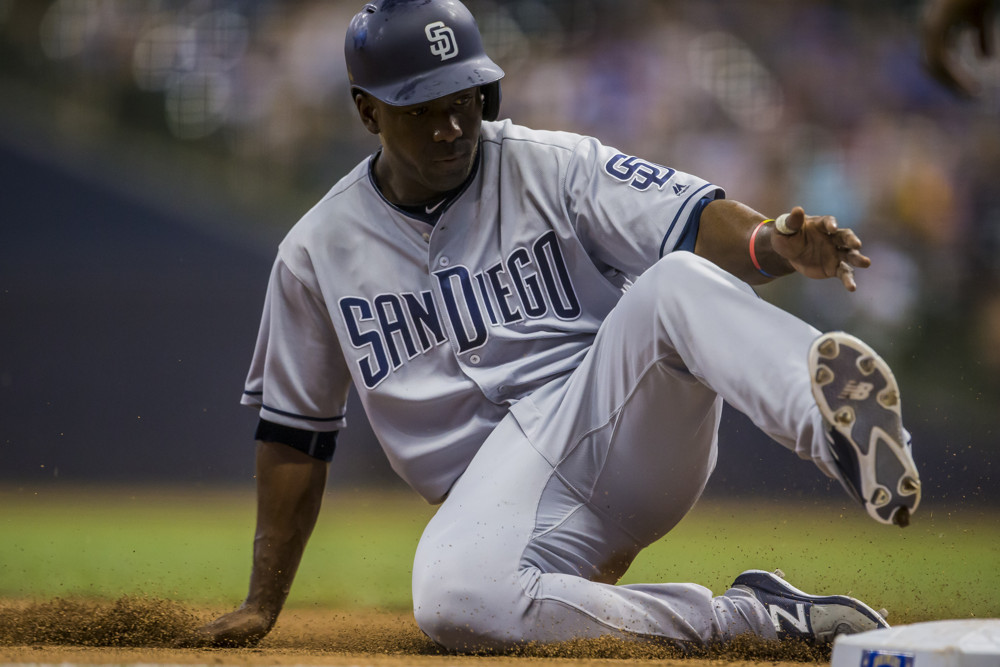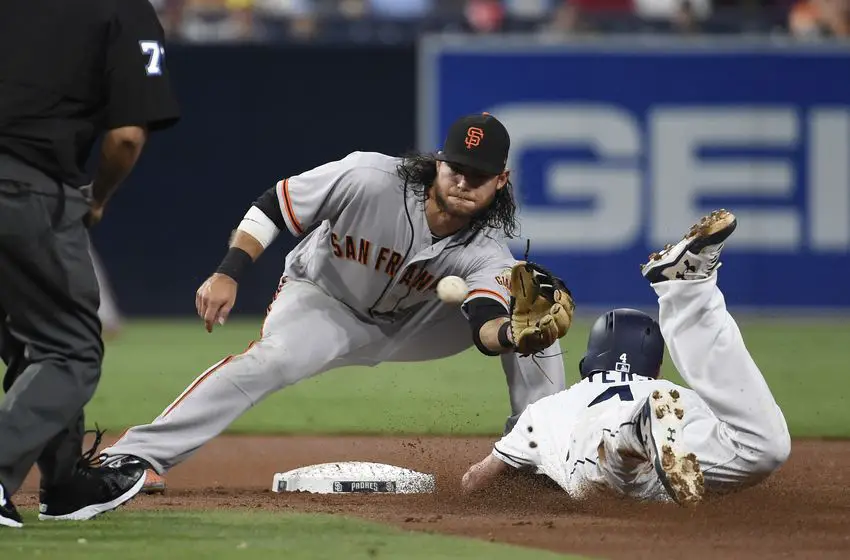The Professor’s Friar Findings: Poor Sliding Leads to Lost Chances


The Professor’s Friar Findings is going to be a new bi-weekly piece for the East Village Times, that will be examining the Padres in a new light.
The new age of baseball has brought about many great things: Statcast showcasing any and all velocities, graphs and charts showing pitchers and hitters in just about any situation imaginable, and any and all stats that the human brain can conceive.
They are all fantastic, and from time-to-time, those will be discussed, but this is going to be more about the subtle beauties that make up the game of baseball.
We have become a society that can overlook certain smaller details because we are so focused on everything going on. I’m going to try to do my best to point out the finer things that the Padres are doing right, or wrong, that may not be talked about on a day-to-day basis. I want this to be interactive. These will be my own opinions and do not reflect the views of the East Village Times staff.
I’m looking for your feedback and always looking for ideas, so please leave a comment or feel free to tweet me @TheProfessorPQ.
Thanks and I hope you enjoy.
The purpose of a slide is to propel oneself towards a base as quickly or as creatively as possible, in order to reach safely. It is an art form, and anyone that says otherwise is probably not very good at it. It takes passion and a willingness to just let yourself go for the betterment of the team. If you are attempting a slide, you have to be all-in or the end result will not get you the desired effect. The Padres, as a team, show no real desire to slide properly.
Full disclosure, I watched every slide I possibly could this year by the Padres, and these are slides that I deemed to be unsatisfactory. Some do not look as bad as others, but they are there for a reason. In order, here is why each made the list:
– Freddy Galvis slows down and then proceeds to start his slide, way, way too early, barely even reaching second base, for a caught-stealing to end the inning.
– Carlos Asuaje looks indecisive on his attempt, slows and turns a steal attempt into an inning-ending pop-up slide.
– Asuaje again slows down, tries to sneak his foot in late, but the damage has been done, another failed steal attempt that ends an inning.
– Franchy Cordero gets caught in-between, not sure what side to attack, and it turns into some sort of dive. Caught stealing.
– No this is not a replay from Galvis’ first attempt, this is a week later, but the same applies; slows down, starts his slide way to early, and gets caught stealing to end the inning.
– Manuel Margot starts his slide way to early and decelerates to the point where he barely gets to the plate.
– Jose Pirela actually gets too close to the base, so he is forced to slow down, which allows the fielder to tag him out to end the inning.
– Margot’s slide here is probably the scariest one. He starts way too late and jams his left shoulder into the ground. Fortunately, he was safe and uninjured on the play.
– Eric Hosmer was trying to get a hustle triple, but fails at the end of it. He slows his momentum and comes up short on a slide for the final out of the inning.
The Padres have been sliding their way out of innings! Now granted, there is no guarantee that any of these plays would have resulted in a safe call, but a better attempt could have led to a better result.
Let’s talk about Freddy Galvis. The gold glove-caliber shortstop is by far the worst offender, mostly because he seems to have the same template for his slides.
Both slides are early. He slows down, taking away from his momentum and simultaneously ends the inning for his team in close ballgames. He looks more concerned about the baseball or the fielder than the end result of the slide, costing his team in the effort. He is effectively killing any chance of scoring more runs.
The most consistent Padre slider this year has been veteran outfielder Matt Szczur. His ability to slide hard, fast, and creatively leads him to have a lot more successful attempts.
Some of these are taken from last year due to lack of footage, but it does not take away from the effective effort in his slides. There is no hesitation, no deceleration, and no regard for anything other than making sure he is safe. The results speak for themselves.
Now, let us look at slides with Galvis and Szczur side by side.

Galvis is clearly starting his slide much later then Szczur, taking away from his slide because he has to travel on the ground longer. The same goes for this shot here with Szczur and Margot, comparing head first slides:

The same applies; Margot starts later and loses the momentum that he creates. He is effectively slowing himself down, and the difference between the two is that Szczur is safe, meanwhile Margot ended an inning. The fact that Margot has a 29.3 sprint speed (ft/sec) compared to Szczur’s 28.3 means nothing.
Speed does not make someone slide better. Sliding should be treated like speed. The Padres are not going to ask A.J. Ellis to steal second because of his speed, so why do they let Freddy Galvis do it despite his poor sliding? There needs to be a bigger emphasis because these little miscues are costing the Padres wins.
The problem with sliding is it can only be taught to a certain point. Every player in Major League Baseball knows the process behind what goes into a slide, but as you can see, it is more than that. There is a mental aspect of it that seems to be lacking in the Padres’ clubhouse; a will and determination to get the job done. The Padres need more effort from their players attempting a slide, or simply put, just stop running themselves out of innings.
Since he was a little kid he wanted to be one of those guys at the game who had the headset on, listening to the Colonel and Uncle Teddy, he has grown out of that, but the love is still there. Padres’ coverage will be biased at times, but mostly an honest dissection of the team he loves.
Definitely a few bad slides; however, Successfully stealing a base depends on so many factors:
*lead off distance
*reaction time to run (the “jump”)
*runner’s speed (billy Hamilton could do a somersault into second if he wanted, haha)
*pitcher’s time to the plate
*catcher’s arm strength and accuracy (szczur is absolutely HOSED with a half decent throw from the catcher)
*slide, which can further be broken down into: optimal start the the slide, location of slide. Head first vs. feet first is interesting…you’re slightly lower profile with sliding head first, but also a bit vulnerable (you can jam your hand/thumb, get stepped on, your arm/shoulder is exposed, etc)…I wonder if that has anything to do with why he chooses to slide feet first.
*situation: running on a fastball count where the pitcher is working away is generally not a good formula; however, running with 2 outs when the top or heart of the lineup is up is often worth the risk.
Interesting thoughts/article on this. Nice work, Prof
Those are some ugly slides. It’s all about the details in baseball.
Less players slide head first because they’re scared to be injured. Major leaguers don’t practice sliding for the same reason. I understand the season is a long grind but they’re sliding on pristine baseball fields. Seasoned ball players will not step on their hands. I played baseball for 12 years all the way up to college and never got my hands stepped when sliding head first. The only time I got stepped on was in softball by players with no baseball background. The only time their hands get hurt are when they jam their fingers on the base. That happens because they don’t practice sliding anymore. I’m also a believer in trucking over the catcher at home instead of doing a hook slide. Old school baby!
I was thinking the same thing but you did the research and laid it down on the article. Great job Patrick.